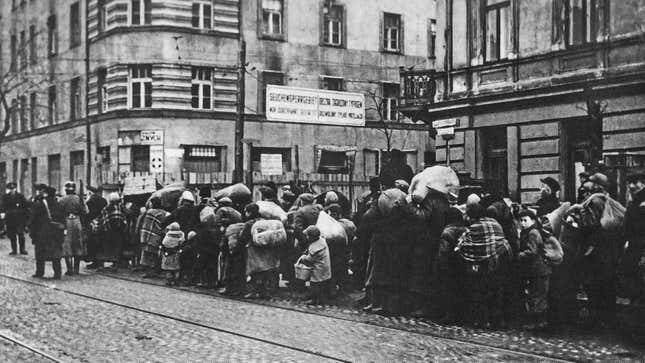
More than 70 years ago, an imprisoned community in Nazi-occupied Poland banded together to contain a deadly epidemic of typhus, largely without the aid of vaccines or effective medicines. Instead, according to new research published today, they likely relied on measures like education, improved sanitation, and even social distancing. Some of the lessons gleaned from that epidemic may very well apply to our current pandemic, the authors say.
Study author Lewi Stone, a mathematician at RMIT University in Melbourne, Australia, has been studying past and recent epidemics for over 30 years, relying on mathematical models to plot out how epidemics spread in a community. Three years ago, he came across accounts of a typhus outbreak in the Warsaw Ghetto of occupied Poland—the largest of the encampments that Nazi Germany established during World War II as a way to segregate the local Jewish population and other targeted groups, with up to 450,000 people living within a space of 1.3 square miles, or over seven people on average per room. But to his knowledge, little work had been done by others to figure out what this outbreak really looked like.
“I began checking historical accounts and was amazed that this had been missed. There was a small amount of data, and upon plotting it, I realized that this was incredibly important,” Stone told Gizmodo.
His team’s findings, published in Science Advances, yielded plenty of surprises.
Epidemic typhus is a bacterial disease notorious for plaguing humanity during times of hardship. It’s transmitted by body lice that feed on the blood of infected people. When the lice reach another host through direct contact or via clothing, their contaminated feces or sometimes even their dead bodies are scratched into an opening in the skin, infecting the new person. Both body lice and typhus spread easiest during wars, famines, or other situations where people are crowded into small spaces with little regard for their health (though rare today, some forms of typhus still occasionally cause outbreaks in prisons, for instance). Without treatment, the flu-like illness is routinely fatal, killing up to 40% of victims.
Typhus had been devastating the Warsaw Ghetto’s residents as late as October 1941, Stone found. But then, it seemed to mysteriously decline by the year’s end, right before the winter, when outbreaks of typhus historically got worse. Initially, Stone worried that death records around that time period may have been incomplete, but he eventually found confirmation of the decline from a historian’s daily accounts of the Ghetto. Nearby towns didn’t experience a similar drop in typhus that winter, indicating that something different was happening in Warsaw.
Though a somewhat effective vaccine for typhus was invented shortly before the start of World War II and may even have been smuggled into the Warsaw Ghetto, few people are thought to have had access to it. And it would be decades before effective antibiotics for typhus would be widely available. So as best as historical records and Stone’s research can tell, it’s likely that members of the community and doctors there relied on more old-fashioned public health measures to stop the outbreak.
These measures included better sanitation and hygiene practices by residents, reinforced by educational lectures that hundreds of people may have attended, according to Stone. There were also reports of underground universities, where young medical students got training on how best to respond to epidemic diseases like typhus. And there was probably some social distancing, though it wouldn’t have been considered a very novel thing at the time.
“It was like common knowledge: ‘Don’t get close to someone with typhus, because you don’t want to be the next person the lice gets onto,’” Stone said.
These measures only mitigated the devastation caused by typhus that year, and the Nazis actively sabotaged efforts to provide people with more food and other resources, worsening the outbreak’s deadliness. Stone’s model suggests that around 100,000 people contracted typhus during that time, many unreported, and it played a large role in the 80,000 to 100,000 deaths that his team also suspects occurred in 1941, along with starvation. But they did probably forestall a much worse outbreak that could have been two to three times larger, Stone said. Sadly, in 1942, many residents of the Ghetto began being sent to the Nazi death camps that ultimately killed millions of people.
Stone’s work began before the covid-19 pandemic, and the two diseases are different in very important ways (among other things, covid-19 is much less fatal than typhus, and it’s spread through respiration, not lice). But he does think his team’s findings are especially timely.
“One takeaway would be that public health measures during an epidemic can be effective—even if you don’t realize they’re working. In Warsaw, most people were starving and probably didn’t know what was going on around them or that what they were doing was really helping,” Stone said.
In studying the buildup to the Warsaw outbreak, Stone also noted the role that the stigmatization of minority communities played. Nazis cited typhus as a reason to isolate Jewish residents in ghettos, and guards shot people who tried to escape, sometimes under the pretense of preventing outbreaks. Covid-19 has similarly affected minority groups in the U.S. disproportionately more than others, and the Trump administration has routinely blamed foreigners for spreading the coronavirus and stoked xenophobia.
Like typhus, covid-19 has a knack for exploiting the divides of the world around it. That doesn’t have to be the end of the story, though. The details might have been different during WWII, but the same principles apply today: A disease spread by people can be stopped by people, too, even in the absence of a miracle cure or vaccine.